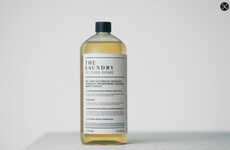
Samsung's New Less Microfiber Filter Catches Small Plastics
References: news.samsung & yankodesign
The new Less Microfiber Filter by Samsung is designed to capture the microplastics that are often in textiles when it goes through washing machines. When washing machines are drained, the dirty water will have the aforementioned microplastics, which find their way to oceans.
In order to stop this from happening, the filter ensures that it will capture about 98% of these microplastics before it reaches the drain. Samsung also notes that this is equal to eight 500ml plastic bottles annually if the wash filter is used four times weekly. Overall, it has a minimal design theme and can sit on top of any standard washing machine. The box itself is constructed from recycled plastic and packaged in sustainable materials.
Image Credit: Samsung
In order to stop this from happening, the filter ensures that it will capture about 98% of these microplastics before it reaches the drain. Samsung also notes that this is equal to eight 500ml plastic bottles annually if the wash filter is used four times weekly. Overall, it has a minimal design theme and can sit on top of any standard washing machine. The box itself is constructed from recycled plastic and packaged in sustainable materials.
Image Credit: Samsung
Trend Themes
1. Microplastic Filter Solutions - Opportunity for the development of more advanced and efficient filters to reduce the impact of microplastics on the marine ecosystem.
2. Sustainable Packaging - Increased focus on packaging sustainability as consumers become more environmentally conscious - packaging made from renewable or recycled materials may offer a competitive advantage.
3. Eco-friendly Household Products - Growing demand for household products that minimize environmental harm may create opportunities for companies to innovate and offer alternatives to traditional products.
Industry Implications
1. Home Appliances - Companies in the home appliances industry may benefit from offering microplastic filter solutions in their products, which can appeal to environmentally conscious consumers.
2. Textile and Fashion Industry - The textile and fashion industry may need to find new ways to manufacture and produce textiles that reduce the amount of microplastics released when washed, therefore driving innovation in this area.
3. Consumer Goods - Companies in the consumer goods industry can take advantage of the growing demand for eco-friendly household products by offering more options that align with consumers' sustainability values.
5.8
Score
Popularity
Activity
Freshness
























